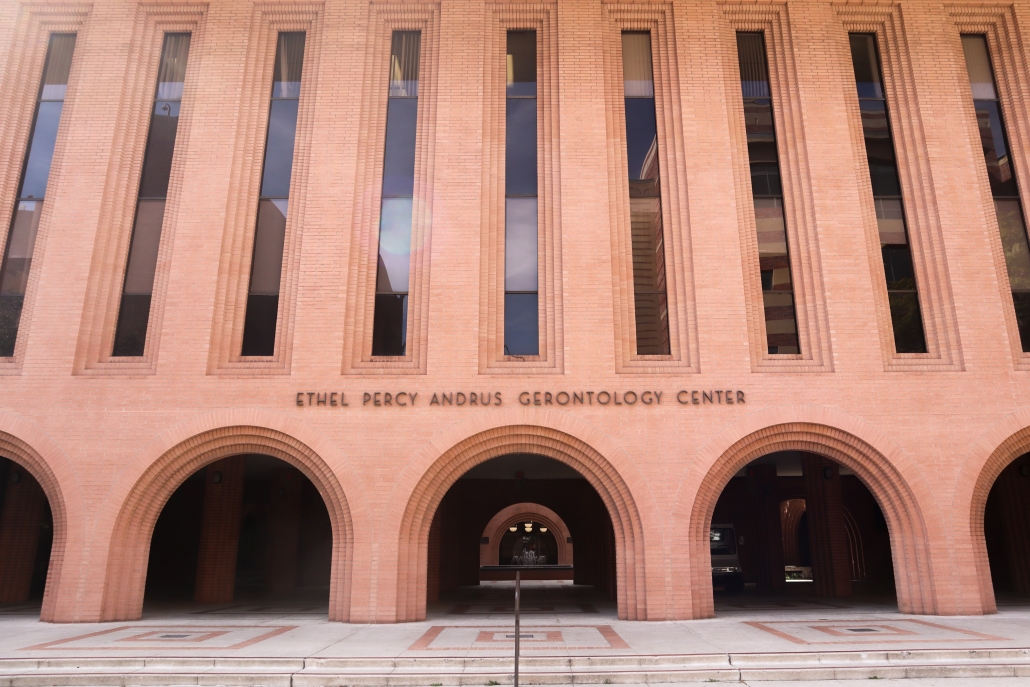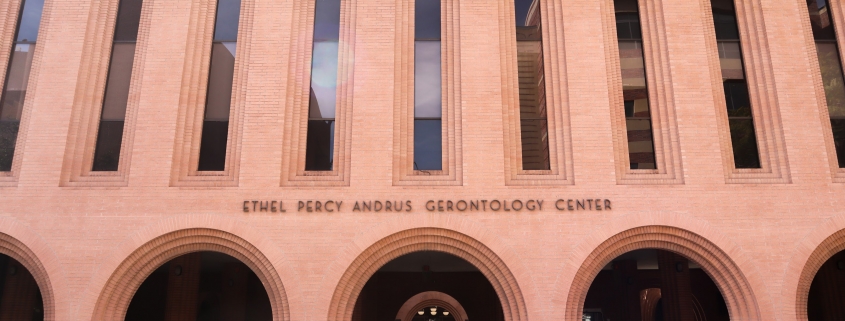Gerontology students live and connect with seniors

On an average day at Kingsley Manor Retirement Community, students hang out in the dining room, casually conversing with their senior neighbors about their favorite shows and teaching them how to use phones.
These students are part of the Davis School of Gerontology’s intergenerational program, which offers gerontology students the opportunity to live with seniors with free room and board to develop practical experience getting along with senior citizens. The Davis school has been collaborating with Kingsley Manor Retirement Community since 1984.
“[Students] understand firsthand the challenges and the rewards of working in that environment, and they understand the needs of those older adults,” said Maria Henke, senior associate dean of the Davis School. “They get to see what the day-to-day lives of older people living in a senior community are like.”
Kingsley Manor Retirement Community currently houses more than 200 residents, who enjoy life after retirement or receive nursing care. Students volunteer 16 hours per week to organize community activities such as TED Talk discussions and socialize with seniors, according to Shaun Rushforth, the executive director at Kingsley Manor Retirement Community.
“The really unique part about the program is that they actually live here, so they become not just a volunteer here but a neighbor to our residents,” Rushforth said.
Nelson Rubio, a graduate student studying aging services management, has been living at Kingsley Manor Home since January 2019. He said he often holds social activities based on residents’ interests. Recently, residents have been interested in virtual reality.
“We are testing virtual reality, which is actually really popular among older adults in our dementia group,” Rubio said. “It’s hard for them to go out in the community often, so it’s a really great tool for them to experience other places.”
Students get to know the residents through daily informal interactions to create a comforting environment for them, Rubio said. Students eat meals with residents in the dining room, he added.
“Sometimes part of the hours is visiting the resident in their room and having a conversation regarding their favorite show [and] listening to music with them,” Rubio said. “Sometimes I have residents teaching me how to play the piano.”
Rubio said he always turns his phone on in case residents call him for help with technology. He has also served as a “matchmaker,” connecting senior residents with friends of his who share common interests.
“I ask what their interests are, and I would find somebody who’s interested in the same things,” Rubio said. “They accommodate and they develop those friendships and it’s easy for them that way.”
Since a lot of senior residents spend most of their day inside, Rubio said he often acts as the residents’ “eyes” by talking with them about what’s happening outside the community.
“We keep them informed of the outside world, which is actually nice because we’re changing a little bit of their routine,” Rubio said. “These are the opportunities to see something different [happening] today.”
Through daily interaction, Rubio has developed friendships with senior residents. He recounted feeling uneasy when one of the residents, who used to co-teach a class with him, didn’t show up for class. He later learned he had passed away that morning.
“You develop friendships that sometimes end too soon,” Rubio said. “That makes you appreciate those moments and it makes you think that while they’re here, how can you make their life better?”
Rubio said he has learned a lot about the importance of being sensitive to senior adults’ difficulties and thinking innovatively to help them overcome these challenges.
“Not everybody has the same needs,” Rubio said. “In order to meet everyone’s needs, you [have to] find creative ways to meet those needs … In order to be successful in this field, you have … to be sensitive and understand the challenges the older adults face as they age.”
Rushforth said residents enjoy chatting with students to gain knowledge of their perspectives on social issues and learning from students about how to use technologies, such as immersive technology.
“The residents appreciate [students’] perspective in conversations and current events,” Rushforth said. “Technology is a big thing that our residents will go to our student volunteers [for, since] they have time and talents in that.”
George Shannon, instructional associate professor at the Davis school, said intergenerational programs satisfy both senior citizens’ need to share experience and students’ need to understand their behaviors.
“It puts together older adults with young kids and fosters understanding and growth on both ends,” Shannon said. “The older adults have this need to communicate and the kids have a need to understand what it is that they’re witnessing in terms of aging.”
Students interested in the program submit their resumes and cover letters to Rushforth, who meets with students to talk about expectations of the program and make sure they are a good fit, Rushforth said.
“We’re looking for students who are going to be here on the long term for a while,” Rushforth said. “They get to know our residents, our residents get to know them.”
Rushforth said every student’s experience in the program has been different, depending on the activities they have organized and the relationships they have formed with senior residents.
“When you pull students who already have that affinity for this demographic and population, there’s genuine affection and friendship that occurs because of that,” Rushforth said. “It is a program where the students can make of it what they want to a certain degree. There’s no two experiences that are the same.”

